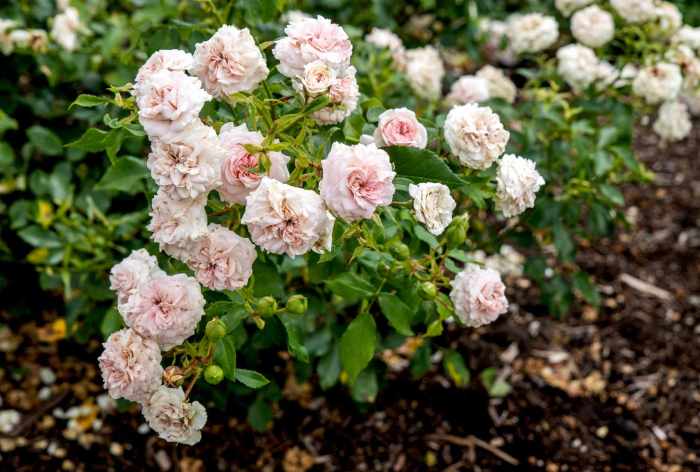How to grow floribunda roses, a captivating journey into the world of these delightful, cluster-blooming beauties! Floribunda roses, known for their abundant blooms and delightful fragrance, are a true delight to cultivate. From choosing the perfect location and soil to mastering the art of pruning and pest control, this guide will equip you with the knowledge to nurture these stunning roses and enjoy their vibrant beauty for years to come.
Imagine a garden overflowing with clusters of vibrant blooms, filling the air with a sweet and intoxicating fragrance. This is the promise of floribunda roses, a captivating variety known for their abundant flowering and captivating charm. Floribunda roses, with their rich history and diverse characteristics, offer a unique and rewarding gardening experience.
Whether you’re a seasoned gardener or just starting your green thumb journey, understanding the nuances of growing floribunda roses is key to unlocking their full potential.
Floribunda Roses: A Symphony of Blooms: How To Grow Floribunda Roses

Floribunda roses, a captivating blend of beauty and resilience, have earned a special place in the hearts of rose enthusiasts worldwide. These charming roses, known for their abundant clusters of smaller blooms, offer a delightful spectacle of color and fragrance in gardens and landscapes.
Their history, growth habits, and wide array of varieties have made them a popular choice for both experienced and novice gardeners.
History and Origin
The Floribunda rose category emerged in the early 20th century, thanks to the innovative work of Danish rose breeder, Poulsen. He successfully crossed hybrid tea roses with polyantha roses, resulting in a new class of roses that inherited the best qualities of both parents.
The resulting hybrids, known as Floribunda roses, possessed the elegant form and fragrance of hybrid teas along with the prolific flowering habit and disease resistance of polyantha roses.
Growth Habits and Characteristics
Floribunda roses are known for their compact, bushy growth habit, making them ideal for smaller gardens and containers. They typically grow to a height of 3 to 5 feet, with a spread of 2 to 4 feet. One of the most striking features of Floribunda roses is their tendency to produce abundant clusters of smaller blooms, often referred to as “floribunda clusters.” These clusters can consist of anywhere from 5 to 20 flowers, creating a stunning display of color and texture.
Types of Floribunda Roses
Floribunda roses come in a wide range of colors, shapes, and sizes, offering a vast selection to suit any garden style. Here are some notable types:
- Cluster-flowered Floribundas:These roses produce large clusters of small, densely packed flowers, creating a dramatic and eye-catching display. Examples include ‘Iceberg’ and ‘The Fairy.’
- Single-flowered Floribundas:These varieties produce individual blooms with a single layer of petals, resembling miniature hybrid tea roses. Examples include ‘Red Pinocchio’ and ‘Amber Queen.’
- Double-flowered Floribundas:These roses feature large, fully double blooms with multiple layers of petals, resembling miniature hybrid tea roses. Examples include ‘Queen Elizabeth’ and ‘Angel Face.’
Popular Floribunda Rose Varieties
The world of Floribunda roses is brimming with captivating varieties, each with its unique charm and appeal. Here are some popular examples:
- ‘Iceberg’: A classic Floribunda rose known for its prolific white blooms and disease resistance. Its clusters of small, double flowers create a breathtaking display throughout the growing season.
- ‘The Fairy’: A charming Floribunda rose with clusters of small, double, pink blooms. Its compact size and abundance of flowers make it a delightful choice for borders and containers.
- ‘Red Pinocchio’: A striking Floribunda rose with single, deep red blooms. Its vibrant color and compact growth habit make it a perfect choice for adding a splash of color to any garden.
- ‘Amber Queen’: A beautiful Floribunda rose with single, apricot-colored blooms. Its delicate fragrance and graceful form make it a delightful addition to any garden.
- ‘Queen Elizabeth’: A classic Floribunda rose with large, double, pink blooms. Its vigorous growth habit and abundance of flowers make it a popular choice for landscaping.
- ‘Angel Face’: A charming Floribunda rose with large, double, white blooms. Its delicate fragrance and graceful form make it a delightful addition to any garden.
Choosing the Right Location and Soil

Just like any other plant, Floribunda roses thrive in the right environment. The key to success lies in choosing the perfect location and soil type that cater to their needs. These roses are known for their abundance of blooms, but they need a bit of TLC to flourish.
Let’s dive into the essential factors that contribute to their growth and health.
Sunlight Requirements
Floribunda roses are sun-loving plants. They need at least 6 hours of direct sunlight daily to produce their vibrant flowers. A location that receives full sun, ideally facing south or west, is ideal. In areas with intense summer heat, a spot with some afternoon shade might be beneficial to prevent scorching.
Soil Type and Drainage
The soil type plays a crucial role in the health of your Floribunda roses. They prefer a well-drained, fertile soil with a slightly acidic pH (between 6.0 and 6.5). Heavy clay soils can retain too much moisture, leading to root rot.
Sandy soils, on the other hand, may not hold enough moisture and nutrients. The ideal soil composition for Floribunda roses is a loam, which is a mixture of sand, silt, and clay.
Importance of Drainage
Good drainage is essential for preventing root rot, a common problem for roses. Waterlogged roots are susceptible to fungal diseases that can damage the plant. To ensure proper drainage, select a location with a slight slope or amend the soil with organic matter like compost or peat moss.
This will improve the soil’s ability to absorb and release water.
Soil Type Comparison
| Soil Type | Advantages | Disadvantages |
|---|---|---|
| Sandy Soil | Excellent drainage, warms up quickly in spring. | Poor water retention, may require frequent watering and fertilization. |
| Clay Soil | Retains moisture and nutrients well. | Poor drainage, can become compacted, leading to root rot. |
| Loam Soil | Good drainage, retains moisture and nutrients, ideal for Floribunda roses. | May require occasional amendments to maintain fertility. |
Planting Floribunda Roses

Planting your Floribunda roses is an exciting step in your gardening journey. It’s essential to choose the right time and follow proper techniques to ensure their successful establishment and growth.
Optimal Planting Time and Depth, How to grow floribunda roses
The best time to plant Floribunda roses is in the early spring or fall. During spring, planting should occur after the last frost, while in the fall, it’s ideal to plant a few weeks before the first frost. This timing allows the roses to establish themselves before the extreme temperatures arrive.When planting, ensure the bud union, the point where the rootstock meets the rose plant, is about 2 inches below the soil surface.
This depth helps protect the bud union from frost damage and encourages the development of a strong root system.
Preparing the Planting Hole and Amending the Soil
Before planting your roses, prepare a well-drained planting hole that is twice as wide and as deep as the rose’s root ball. This allows for ample space for root growth and encourages healthy development.Next, amend the soil with organic matter, such as compost or aged manure.
This improves soil structure, drainage, and nutrient content, creating an ideal environment for your roses to thrive. The addition of organic matter also helps retain moisture and provides essential nutrients.
Planting Technique
1. Dig the Hole
Dig a hole that is twice as wide and as deep as the root ball.
2. Loosen the Soil
Floribunda roses are known for their abundant clusters of blooms, and they’re relatively easy to grow. If you want to expand your rose collection, you can try propagating them from cuttings, similar to how you would propagate camellias.
Just be sure to take cuttings from healthy, mature stems and use a rooting hormone for best results. Once your new floribunda rose plants are established, you’ll be rewarded with a vibrant display of color throughout the season.
Use a garden fork or shovel to loosen the soil at the bottom of the hole. This encourages root growth.
3. Amend the Soil
Mix a generous amount of compost or aged manure into the soil in the hole.
4. Position the Rose
Place the rose in the hole, ensuring the bud union is 2 inches below the soil surface.
5. Backfill the Hole
Gently backfill the hole with the amended soil, making sure to avoid compacting the soil around the roots.
6. Water Thoroughly
Water the rose deeply to settle the soil and encourage root establishment.
7. Mulch
Floribunda roses are known for their abundant clusters of blooms, adding a burst of color to any garden. To ensure their vibrant growth, it’s essential to provide them with the right amount of water, especially during scorching heatwaves. You can learn more about how to keep your plants hydrated during these extreme temperatures by reading this helpful article on how to water plants during a heatwave.
With proper watering, your floribunda roses will flourish and reward you with a dazzling display of blooms throughout the season.
Apply a layer of organic mulch, such as wood chips or shredded bark, around the base of the rose, but not touching the stem. This helps retain moisture and suppress weeds.
Diagram:Imagine a circular hole in the ground, slightly wider than the rose’s root ball. The rose is placed inside the hole, with the bud union 2 inches below the soil surface. The hole is then backfilled with amended soil, leaving a small mound around the base of the rose.
Watering and Fertilizing

Floribunda roses are known for their prolific blooming, but to achieve this, they require proper watering and fertilization. Just like any other plant, these roses need consistent hydration and essential nutrients to thrive.
Watering Floribunda Roses
Regular watering is crucial for Floribunda roses, especially during dry periods. The soil should be kept consistently moist but not waterlogged. Here are some guidelines:
- Water deeply and infrequently, allowing the soil to dry slightly between waterings. This encourages deeper root growth, making your roses more drought-tolerant.
- During hot weather, water your roses in the early morning or late evening to minimize water evaporation.
- Avoid watering the foliage, as this can lead to fungal diseases.
- Use a watering can or a soaker hose to deliver water directly to the roots.
Fertilizing Floribunda Roses
Floribunda roses are heavy feeders and benefit from regular fertilization. The best time to fertilize is in spring, after the first flush of blooms, and again in mid-summer.
- Use a balanced fertilizer specifically formulated for roses, with a ratio of nitrogen (N), phosphorus (P), and potassium (K) of 10-10-10 or similar.
- Apply fertilizer according to the manufacturer’s instructions, typically a few tablespoons around the base of each rose bush.
- Avoid fertilizing during hot, dry weather, as this can burn the roots.
Benefits of Organic Fertilizers
Organic fertilizers, such as compost, manure, and fish emulsion, offer numerous benefits for Floribunda roses and the overall soil health:
- They provide slow-release nutrients, ensuring a steady supply to the plants.
- They improve soil structure and drainage, enhancing root growth.
- They increase beneficial microbial activity in the soil, leading to healthier plants.
- They are environmentally friendly and sustainable.
Organic fertilizers are a natural and beneficial way to nourish your Floribunda roses while improving the overall health of your garden.
Pruning Floribunda Roses

Pruning Floribunda roses is an essential practice for promoting healthy growth and encouraging abundant blooms. By removing dead or diseased branches and shaping the plant, you can ensure that your roses receive adequate sunlight and air circulation, leading to stronger stems and more vibrant flowers.
Pruning Techniques
Pruning Floribunda roses involves various techniques, each serving a specific purpose.
- Deadheadinginvolves removing spent blooms to encourage the plant to produce new buds and flowers. This technique helps to maintain a continuous display of blooms throughout the growing season. Deadheading can be done throughout the growing season, from spring to fall.
- Thinningis the process of removing weak, diseased, or crossing branches to improve air circulation and sunlight penetration. Thinning helps to promote stronger growth and reduce the risk of diseases. It is best done in late winter or early spring before new growth emerges.
- Shapingis a technique used to control the size and shape of the rose bush. It involves removing branches that are growing in undesirable directions or that are interfering with the overall form of the plant. Shaping can be done throughout the growing season, as needed.
Pruning Floribunda Roses at Different Times of the Year
The timing of pruning depends on the climate and the desired outcome.
- Late Winter or Early Spring:This is the ideal time for major pruning, as the rose bush is dormant. This is the time to remove dead, diseased, or damaged branches, as well as to thin out the plant and shape it. During this time, cut back stems to about 1/3 of their length, leaving 3-5 buds on each stem.
- Early Summer:This is the time for deadheading and light pruning to encourage new growth and more blooms. Remove spent flowers and any branches that are growing too long or in an undesirable direction.
- Late Summer or Early Fall:This is the time to prune back any branches that have grown too long or are interfering with the shape of the bush. This will help to prevent the plant from becoming too leggy and will encourage the growth of new buds for the following year.
Avoid heavy pruning during this time as it can stimulate new growth that may not have time to harden off before winter.
Pest and Disease Control

Even with the best care, Floribunda roses are susceptible to a range of pests and diseases. Recognizing these issues early and implementing timely preventative and control measures is crucial to maintaining healthy, vibrant blooms.
Common Pests and Diseases
Floribunda roses can be affected by various pests and diseases, each with distinctive symptoms. Identifying these problems early allows for timely intervention and prevents significant damage to your plants.
- Aphids: These tiny, soft-bodied insects are often found clustered on the undersides of leaves, stems, and buds. They feed on plant sap, causing leaf curl, stunted growth, and distorted buds. Aphids can also transmit viral diseases.
- Spider Mites: These microscopic pests spin fine webs on the undersides of leaves, where they feed on plant sap. They cause yellowing, stippling, and eventual browning of leaves.
- Rose Slugs: These slimy, green caterpillars feed on leaves, leaving behind irregular holes. They are particularly active in moist conditions.
- Japanese Beetles: These metallic green beetles feed on leaves, skeletonizing them by leaving only the veins intact.
- Black Spot: This fungal disease manifests as black spots on leaves, often accompanied by yellowing and leaf drop.
- Powdery Mildew: This fungal disease appears as a white, powdery coating on leaves, stems, and buds. It can stunt growth and cause leaves to become distorted.
- Rose Rust: This fungal disease causes orange or brown pustules on the undersides of leaves, leading to yellowing and leaf drop.
Preventing and Controlling Pests and Diseases
A combination of preventive measures and timely intervention is key to managing pests and diseases in your Floribunda roses.
Preventive Measures
- Choose Disease-Resistant Varieties: Select Floribunda rose cultivars known for their resistance to common pests and diseases.
- Provide Proper Growing Conditions: Ensure adequate sunlight, good air circulation, and well-drained soil to minimize the risk of fungal diseases.
- Maintain Plant Health: Regularly inspect your roses for signs of pests and diseases. Water deeply and consistently, and fertilize appropriately to promote strong, healthy growth.
- Clean Up Debris: Remove fallen leaves, stems, and other debris around your roses to reduce overwintering pests and disease spores.
Controlling Pests and Diseases
- Natural Methods:
- Insecticidal Soap: This soap-based solution disrupts the cell membranes of insects, causing them to dehydrate and die.
- Neem Oil: This oil extracted from the neem tree has insecticidal and antifungal properties. It can be applied as a spray to control pests and diseases.
- Horticultural Oil: This oil suffocates and kills insects by blocking their breathing pores. It is effective against overwintering insects and eggs.
- Diatomaceous Earth: This finely ground fossilized algae is a natural insecticide that works by abrading the exoskeletons of insects.
- Companion Planting: Planting garlic, onions, and other aromatic herbs around your roses can help deter pests.
- Beneficial Insects: Encourage the presence of beneficial insects like ladybugs and lacewings, which prey on aphids and other pests.
- Chemical Methods:
- Insecticides: These chemicals target specific pests, but their use should be carefully considered due to potential environmental and health impacts.
- Fungicides: These chemicals are designed to control fungal diseases.
Identifying and Treating Specific Pest and Disease Problems
- Aphids: If you notice aphids on your roses, you can try knocking them off with a strong jet of water or using a mild insecticidal soap solution.
- Spider Mites: To control spider mites, use a strong jet of water to dislodge them or apply a horticultural oil spray.
- Rose Slugs: Handpick rose slugs from your plants or use a natural insecticide like Bacillus thuringiensis (Bt).
- Japanese Beetles: Handpick Japanese beetles from your roses or use a trap to catch them.
- Black Spot: Remove infected leaves and stems and dispose of them properly. Apply a fungicide if necessary.
- Powdery Mildew: Remove infected leaves and stems and dispose of them properly. Apply a fungicide or a baking soda solution.
- Rose Rust: Remove infected leaves and stems and dispose of them properly. Apply a fungicide.
Propagation and Winter Care

Expanding your floribunda rose collection is a rewarding endeavor, and understanding propagation techniques allows you to create new plants from existing ones. Additionally, winter care is crucial for ensuring the survival and health of your roses in colder climates.
Propagation Methods
Propagation techniques allow you to create new floribunda rose plants from existing ones, expanding your collection and sharing your passion with others.
- Cuttings: This method involves taking stem cuttings from healthy floribunda roses. Cuttings should be taken from new growth, ideally in the spring or early summer. Select stems that are about 6-8 inches long and have at least four leaves.
Remove the leaves from the bottom inch or two of the stem and make a diagonal cut at the base. Dip the cut end in rooting hormone and insert the cutting into a pot filled with a well-draining potting mix.
Keep the cuttings moist and in a warm, bright location. Rooting typically takes several weeks, and once roots have formed, you can transplant the cuttings into individual pots or directly into the garden.
- Layering: Layering involves bending a stem of the floribunda rose to the ground and burying a portion of it in the soil. This method encourages the stem to develop roots, creating a new plant. Select a healthy stem that is flexible enough to bend to the ground.
Make a shallow cut in the stem, about 1 inch from the tip. Bury the cut portion of the stem in the soil, leaving the tip of the stem exposed. Secure the stem in place with a wire or stone.
Keep the soil moist and after several weeks, roots should form. Once the new plant has established roots, you can sever it from the parent plant and transplant it to a new location.
Winter Protection
Floribunda roses, while hardy, require protection during winter in colder climates to prevent damage from frost and extreme temperatures. Winter protection helps maintain the health of the rose bushes and ensures a bountiful bloom in the following spring.
- Mulching: A layer of mulch applied around the base of the rose bushes helps insulate the roots and protect them from freezing temperatures. Use organic materials like wood chips, shredded bark, or straw for mulching. Apply a layer of mulch that is about 4-6 inches deep, making sure it does not touch the stems.
- Covering: In areas with very cold winters, additional protection may be necessary. Cover the rose bushes with burlap sacks, frost blankets, or other protective materials. Ensure the covering is breathable to allow air circulation and prevent moisture buildup.
Epilogue

With the right care and attention, your floribunda roses will thrive, rewarding you with a breathtaking display of color and fragrance throughout the season. From choosing the perfect location and soil to mastering the art of pruning and pest control, this guide has equipped you with the knowledge to nurture these stunning roses and enjoy their vibrant beauty for years to come.
So, roll up your sleeves, get your hands dirty, and embark on this exciting journey of growing floribunda roses, a true testament to the magic of nature and the joy of gardening.